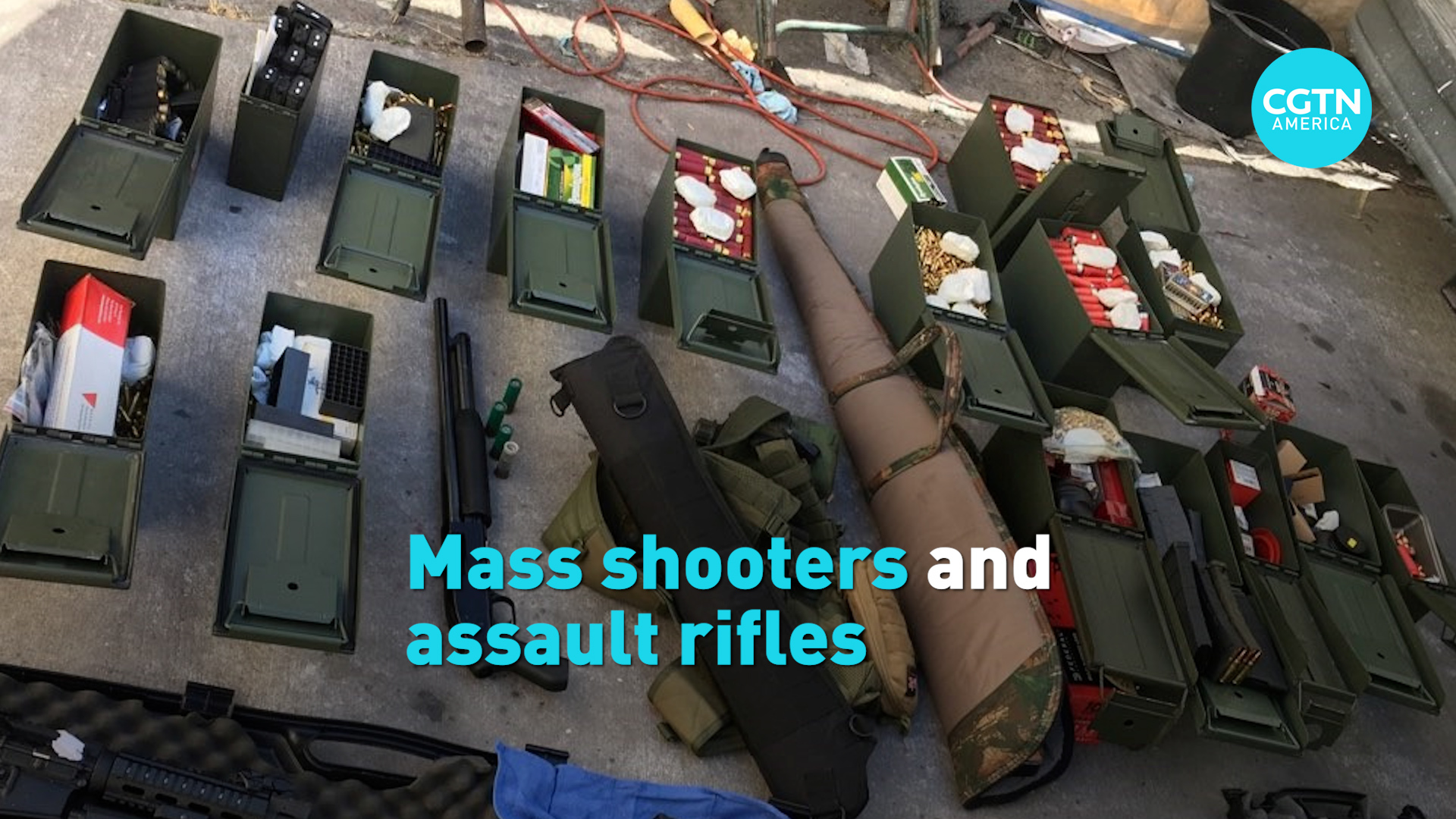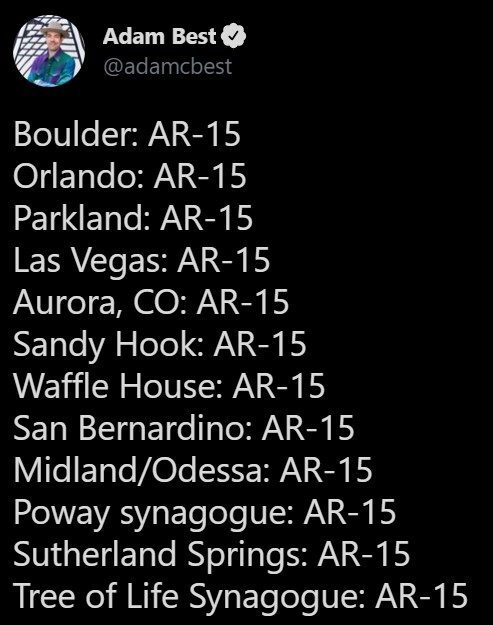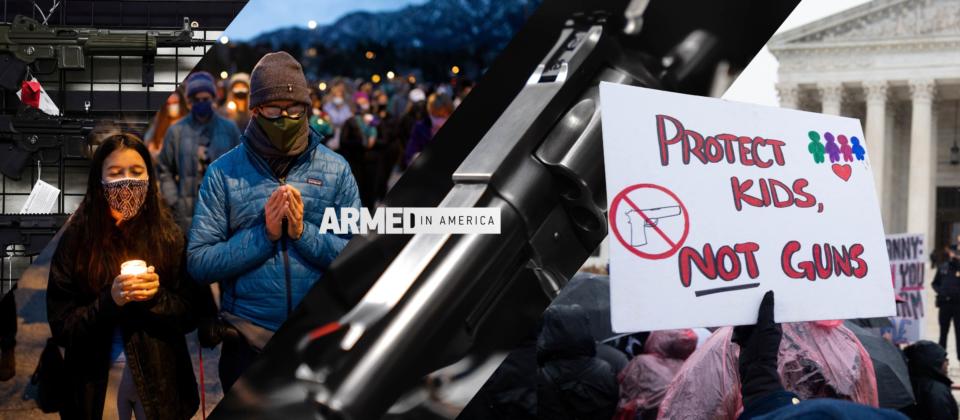Residents of two separate communities in California are reeling from two separate mass shootings that happened in three days apart from each other and have claimed 18 lives and injured 10 people. Motives behind both attacks are still under investigation, but Asian-American communities impacted by the latest round of gun violence are on edge, as it comes after a trend of rising anti-Asian hate crimes across the country.
The latest tragedies have triggered new debates around self-defense for individuals, as well as a federal gun safety reform.
CGTN’s Ediz Tiyansan reports.
On 7/11/2021, During an illegal exhibition of speed event at Barneveld & McKinnon, a passenger leaned out of a Cadi holding an AK47; see photo. SFPD Traffic Company personnel worked up a case, and seized this particular vehicle today. @SFPD @sfmta_muni @SFPDPerea pic.twitter.com/4disQpzziY
— SFPDTrafficSafety (@SFTrafficSafety) August 5, 2021
A spate of mass shootings amid record gun sales, especially among African-Americans and other minorities in the U.S., and a new president determined to stop the bloodshed.
All of this as America’s most prominent gun group faces a threat to its existence.
Lawmakers call for renewed assault rifle ban following wave of mass shootings
Democrat lawmakers in the U.S. say they’re moving forward with a new ban on the kind of assault weapons used in the mass shootings at a Texas elementary school and a supermarket in the city of Buffalo.
If passed, this would represent one of the toughest political responses to a string of mass shootings using high-powered guns.
This kind of ban has been tried before.
CGTN’s Owen Fairclough reports.
According to the firearms industry’s trade association, millions of Americans bought their first ever gun in 2020.
And, as CGTN’s Giles Gibson reports, many of these new gun owners are African Americans and Asian Americans.
A state of emergency has been declared in an effort to tackle a surge in shootings over the past year and a half.
And with it, an infusion of new funds to help stem this trend.
CGTN’s William Denselow reports from New York.
In our Armed in America series, CGTN’s Owen Fairclough explores the facts on U.S. gun culture and policy.
Armed in America: U.S. vs. global gun violence
The U.S. has long drawn international attention for both its high gun-related death toll and the quantity of firearms that American civilians possess.
And yet while there are plenty of countries where low gun crime corresponds with low gun ownership, that isn’t always the case.
Armed in America: A brief history of the 2nd Amendment
U.S President Joe Biden’s recent executive orders on gun control were met by familiar objections from opponents.
They claim their Second Amendment rights are at risk. Even so, plenty of legislation has been passed despite this cornerstone of the U.S Constitution. So why does it matter so much?
National Rifle Association on the defensive for its 150th anniversary
Few, if any, nonprofit organizations can match the clout of the National Rifle Association.
It was founded 150 years ago and has been credited with both significant victories against gun control and helping to elect pro-gun presidents. But the NRA is in financial and legal trouble as it tries to secure its future.
Joe Biden tests Republican waters on gun control
After nearly four months in office devoted mostly to the pandemic, U.S. President Joe Biden has turned his attention to perhaps the single most polarizing topic in American life: guns.
In the first two weeks of April, 96 Americans have been victims of mass shootings. Thirty of them died.
In 2019, nearly 40,000 people were killed by firearms – in both homicides and suicides. That’s averaging more than 106 a day. But the right to bear arms is protected by the U.S. Constitution.
And Biden is merely the latest president to try to introduce controls on who can buy firearms and what models they’re allowed.
And yet even small changes to components, rather than guns themselves, are at risk of being undone by those who consider legislation an infringement of their civil liberties.
In the first of our series, Armed in America, CGTN’s Owen Fairclough looks at guns and the law.
Who owns a gun in America?
As many in the U.S. attempt to resume their pre-pandemic routines, gun violence is rising across the country. And so are gun sales.
A record 21 million people went through background checks to buy a gun last year, according to the National Shooting Sports Foundation. A survey from the foundation also found that 40% of those people were first-time gun owners.
A 2017 survey by the Pew Research center found 30% of U.S. adults said they owned a gun, while 11% said they didn’t personally own one but lived with someone who did.
Among the group of those who didn’t currently own a gun, about half said they could see themselves owning one in the future.
The pandemic, civil unrest, and mass shootings are encouraging many Americans to buy their first gun.
Pew Research Center reports, handguns are the most common type of guns owned in the U.S., with personal protection being the top cited reason for buying one.
But what are the demographics of gun ownership in the country?
The 2017 Pew survey found guns more common among men than women, and among White people compared to Blacks.
Overall, 39% of men and 22% of women said they personally owned a gun.
While 36% of Whites, 24% of Blacks, and 15% of Hispanics said they owned a gun.
Where you live in the U.S. can factor into gun ownership.
Pew found that while ownership varied, people who live in rural areas of the country were more likely to own a gun.
Those who lived in the Southern region of the U.S. were also more likely to own one compared to the rest of the country, according to Pew.
Pew’s survey found education and political affiliation could also influence gun ownership.
Overall, 31% of owners had a high school education or less, and 34% had some college education.
“Republicans and Republican-leaning independents are more than twice as likely as Democrats and Democratic-leaning independents to say they own a gun (44% vs. 20%),” said Pew.
Still, pinpointing the exact number of U.S. gun owners is difficult since there is no national registration requirement.
Gun analysts say along with increased sales of guns, hoarding and panic-buying of ammunition likely led to a current nationwide shortage of ammo.
According to the Geneva-based Small Arms Survey research group, the U.S. is the most heavily armed society in the world.
The group says about 121 firearms are in circulation for every 100 people.
And the demographics behind gun ownership may be changing.
The National Shooting Sports Foundation survey of gun sales last year found purchases by Black Americans up 56%, more than any other race. The owner of Redstone Firearms, California’s only Black-owned gun shop told NPR she’s noticed a particular increase in Black women coming to the store to buy a gun.
AR-15 rifles: How do mass shooters get them, and what can be done?

A recent viral Tweet accurately recounted the one thing 12 mass shootings in America had in common: the use of an AR-15 style rifle to kill people.

While critics complain that not all of the weapons used in these shootings were specifically AR-15 rifles, Snopes and other fact-checkers note that while the Colt Manufacturing Company owns a trademark on the “AR-15” name, guns described as “AR-15 style weapons” are practically identical to Colt’s AR-15, but manufactured by a different company.
In the aftermath of the recent shooting in Boulder, Colorado, U.S. President Joe Biden urged Congress to pass new gun restrictions and renewed calls for a ban on assault rifles and high-capacity ammo magazines.
The decision of whether or not to ban assault rifles and high-capacity magazines has been a subject of intense debate with gun rights advocates casting doubt on its effectiveness in preventing mass shootings like those listed above.
What follows is a look at the five most recent shootings listed on the viral meme, how the shooters managed to acquire the assault weapon they used to kill, and what affect, if any, an assault rifle ban would have had on their respective cases.
Location: Boulder, Colorado
Date: March 22, 2021
Casualties: 10 people killed
Assault weapon: Ruger AR-556 pistol
The shooter bought the AR-556 (which is essentially a slightly shorter version of a full AR-15 rifle) legally. A few days prior, Boulder County District Court had overturned a 2018 assault weapons and high-capacity magazine ban, but since the shooter lived in a different county, the regulations would likely not have affected him. The only way an assault weapons ban would have affected him would be if it was a statewide or nationwide ban.
His family said he was paranoid, disturbed and antisocial. Classmates said he had a temper. He’d served probation in 2017 for punching another student. By the time of the shooting, he also had a semi-automatic handgun and tactical gear. So in addition to enforcing an assault weapons ban, a background check would have needed to be robust enough to disqualify him from owning a rifle based on previous acts of violence (though in this case, the shooter had only one third degree charge)
Location: Midland and Odessa, Texas
Date: August 31, 2019
Casualties: 7 people killed, 25 injured
Assault weapon: Anderson Manufacturing AM-15
This case is notable in that it is the only one where the shooter bought his assault weapon illegally from a private dealer. He’d been prohibited from purchasing a gun after he failed his national criminal background check and was legally declared mentally unfit. So he bought the AM-15 from a private dealer to avoid a background check altogether. The man who sold him the rifle was subsequently arrested and charged with dealing without a license. The dealer had also sold guns to a convicted felon, a man under felony indictment, and an immigrant who was in the U.S. illegally. The only way an assault weapons ban would have been effective in a case like this is if it included heavy regulation on private vendors and crackdowns on anyone selling or attempting to purchase weapons without a background check.
Location: Poway Synagogue, Poway, California
Date: April 27, 2019
Casualties: 1 person killed, 3 injured
Assault weapon: Smith & Wesson M&P15
The shooter bought the M&P15 legally thanks to a loophole in a recent California law. The law prohibited anyone under the age of 21 from purchasing a rifle, UNLESS they had a hunting license valid in California (which the shooter did).
A full ban on assault weapons might have prevented the shooter from buying the M&P15, or at the very least, the state loophole would need to have been closed so that any guns designated as ‘assault weapons’ would be disqualified from the hunting exemption. Background checks alone would not have stopped this as the shooter had no previous criminal record or extremist ties.
Location: Parkland, FL
Date: February 14, 2018
Casualties: 17 people killed, 17 more injured
Assault weapon: Smith & Wesson M&P15 Sport II
The Parkland shooter bought the assault rifle legally (along with several other weapons) after he passed the required background check. This fact came under intense scrutiny in the aftermath of the shooting because there were multiple red flags that were a matter of public record: He had a history of making threats against other students, years of behavioral problems, and social media posts expressing a desire to kill people and mimic the University of Texas tower shooting. The FBI and Broward County Sheriff’s Office faced sharp public criticism for failing to stop the shooter despite previous reports and investigations into the shooter’s behavior. After the shooting, Florida raised the minimum age for buying guns to 21, established waiting periods and background checks, and barred some potentially violent or mentally unhealthy people arrested under certain laws from possessing guns.
A ban on assault weapons would have stopped the shooter from buying the M&P15 rifle he used for the shooting, but it should be noted that he reportedly had purchased other guns, so further measures would involve nationalizing the age change and making the disqualification of “violent” and “mentally unhealthy” people from purchasing weapons more enforceable with a clear standard for how red flags can be found in background checks.
Location: Tree of Life Synagogue, Pittsburgh, Pennsylvania
Date: October 27, 2018
Casualties: 11 killed, 6 injured
Assault weapon: Smith & Wesson M&P15
The shooter bought the M&P15 legally along with 3 Glock handguns. His social media history (including multiple posts on the right-wing platform Gab) showed that he had been radicalized as a white nationalist, frequently posted antisemitic conspiracies, expressed a desire to kill Jews, and frequently posted pictures of his guns (as he called them, his “Glock family”) and target practice. In the aftermath of the shooting, Pennsylvania passed laws restricting the use of assault weapons, banning most uses of armor-piercing rounds and high capacity magazines, and allowing the temporary seizure of guns from people determined to be a danger to themselves or others.
The state walked back an outright ban on assault weapons on the grounds that it would likely have been struck down in court. A ban would likely have reduced the body count, but it might not have prevented the incident altogether. Further regulations would likely have been needed to strengthen background checks to include social media posts and ties to extremist groups, officially designated white supremacy groups, and subjects under investigation for domestic terrorism.
Gun market soars after Brazil president loosens restrictions
Brazil’s gun market has soared in recent years following President Jair Bolsonaro’s actions to facilitate access.
Those against such measures say more weapons bought in the name of safety will just make the country a more dangerous place.
CGTN’s Paulo Cabral reports.
 CGTN America
CGTN America


